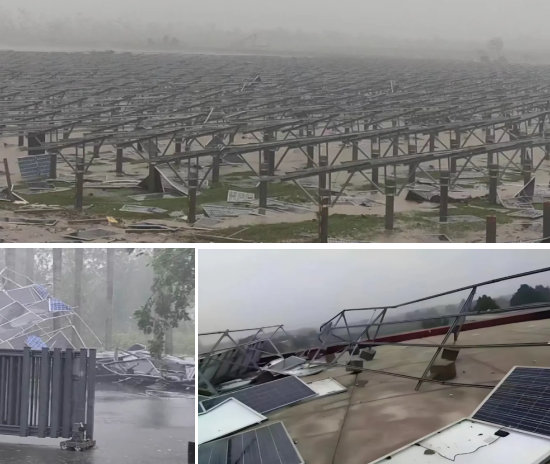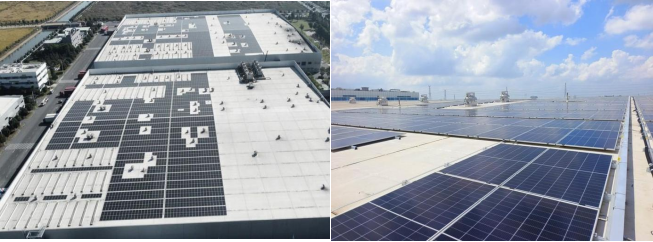PVTIME – In summer 2024, extreme weather events occurred frequently in South Asia, particularly typhoons crossing the Pacific Ocean to the East China Sea. Following the impact of a powerful Typhoon Yagi on southern China, numerous aspects of life in the region were disrupted, with approximately one million people in the country’s south evacuating their homes to avoid the severe weather. Additionally, the disaster resulted in damage to renewable power infrastructure, including rooftop solar systems and solar photovoltaic plants.
Following the devastation wrought by Typhoon Yagi in Hainan, the Leizhou Peninsula, Vietnam and Myanmar, Typhoon Bebinca made landfall in Shanghai on the morning of 16 September, subsequently making its way deep into the interior of China. The typhoon caused severe damage in Shanghai, Zhejiang, Jiangsu, Anhui, Henan and Shandong provinces. As Bebinca was approaching landfall, another typhoon, Pulasan, developed in the waters around Guam. This was the same area where Bebinca had developed a few days earlier and was also heading towards the east China coast. During this period, a significant number of individuals and businesses experienced disruptions to power and communication services, with some locations also reporting damage to residential and commercial properties.
From 4 to 7 September, Super Typhoon Yagi made landfall in Hainan Province, Guangdong Province of China and on the coast of Vietnam. This is the most powerful autumn typhoon to hit China since Super Typhoon Rammasun swept across southern China and the Philippines many years ago. Yagi rapidly intensified and made landfall with significant destructive impact for an extended period of approximately 65 hours, with maximum wind speeds near the centre exceeding 63 m/s in level 17. The super typhoon affected 19 cities and counties in Hainan Province, with approximately 526,100 people impacted by the disaster. Four deaths and 95 injuries were reported. The economic impact of Yagi is significantly greater than that of Rammasun. Direct economic losses in Haikou City exceed 26.3 billion yuan (approximately US$ 3.75 billion), while in Wenchang City, the figure stands at over 32.7 million yuan (approximately US$ 4.66 billion).
Many photovoltaic solar power plants were significantly impacted by the disaster, resulting in extensive damage to photovoltaic modules and ancillary equipment. This has prompted the industry to prioritise enhancing wind resistance, optimising post-disaster handling, and advancing environmental protection, recycling, and other crucial areas.

Hainan Province is an amazing location for solar photovoltaic power deployment. The city of Wenchang is ideally located for the development of photovoltaic power generation, benefiting from a low latitude, abundant sunlight with high intensity and long duration, as well as clean air. In recent years, numerous centralised PV plants, including fishery PV and agricultural solar farms, have been launched in Wenchang City, with an installed capacity of over 100 MW each. Meanwhile, another city named Xuwen in Guangdong Province, which was hit by Yagi, has been selected as one of the cities for PV+ projects with a large area of photovoltaic installed. Xuwen is surrounded by the sea on three sides, both onshore and offshore, including coastal mudflats, shrimp ponds and other pools, and is therefore a perfect location for fishery photovoltaic projects. However, the majority of solar panels on fishery photovoltaic solar plants were torn apart during the Typhoon Yagi.
The PV solar plants are designed to withstand typhoons with wind speeds of at least 32.6 m/s. In line with international standards such as IEC 61215 and IEC 61730, the national standards GB 50797 ‘Code for the Design of Photovoltaic Power Plants’ and GB 50009 ‘Code for Structural Loads on Buildings’ provide the framework for the design of racks and foundations for photovoltaic power plants.
However, the maximum wind speed of Yagi was recorded at 62 m/s near the centre of Wenchang City at 16:00 on 6 September 2024. The lowest pressure was 915 hPa. The maximum wind speed near the centre was also recorded at 58 m/s when it landed a second time in Xuwen, Guangdong Province, at 6:22 pm that night. How strong a typhoon with such speed in level 17 would be? The speed of that wind is comparable to that of a moving train, with cars being blown away like leaves and cottages being blown over.

Hainan Holding Energy Co., Ltd., a local provider and operator of electric and energy supply and related services, has announced that following the Yagi incident, a number of its assets, primarily distributed solar photovoltaic plants owned by the company and its subsidiaries, have been damaged. Additionally, some of its raw materials have been subjected to moisture, which has had a detrimental impact on its daily operations. The preliminary estimate of the impact on value is approximately 43 million yuan (equivalent to US$ 61.275 million).
Jinko Power Technology Co., Ltd., a leading Chinese clean energy supplier and service provider, has announced that the impact of Typhoon Yagi has resulted in certain asset losses at its fishery solar power station in Xuwen, Guangdong Province. Following a preliminary on-site investigation, it has been determined that the modules, inverters, brackets, cable bridges, pipe piles and other devices have been damaged to varying degrees. Further investigation is required to ascertain the extent of damage to this 400MW PV station, given the size of the site and the volume of work involved. It is estimated that the asset losses caused by Yagi may exceed 10% of its net profit in 2023. According to publicly available data, Jinko’s net profit for the 2023 financial year was 383 million yuan (approximately US$54.58 million). This would mean that the loss of this Xuwen PV power station caused by Yagi may exceed 38.3 million yuan (approximately US$5.458 million).
Furthermore, another photovoltaic solar station in Yazhou, which is the first centralised PV plant of the Three Gorges Group in Hainan, has also been reported as damaged. Fortunately, the overall loss can be controlled to a minimum, and the long-term operation was not significantly impacted. Some modules were slightly damaged, a small number of piles showed signs of settlement, and soil erosion occurred after Yagi passed by.
At approximately 7:30 on 16 September, this year’s 13th typhoon Bebinca made landfall on the coast of Shanghai, becoming the strongest typhoon to land in Shanghai since 1949. Some PV power stations in Shanghai, Jiangsu and other nearby locations sustained significant damage during Bebinca’s passage through the region.
In anticipation of the alert, numerous PV companies had already taken steps to safeguard their solar facilities.
China Huadian Co., Ltd. (CHD), a core power supplier in China, promptly enacted the emergency plan and implementing comprehensive protection measures for its solar PV plants across seven regions, including Jiangsu, Zhejiang, Shanghai and other locations. The photovoltaic plants were subject to a thorough inspection and any necessary reinforcement was completed in advance.
Valin New Energy, a leading provider of solar trackers and frames, is pleased to see the distributed solar system on the roof of Jahwa in Qingpu District, Shanghai, which was on the path of Typhoon Bebinca. The 4MW solar project demonstrated resilience in the midst of the storm’s intense core, with wind speeds reaching 37.0 to 41.4 m/s.
The Jahwa Shanghai 4MW flexible roof distributed photovoltaic power plant, located in Qingpu District, Shanghai, was in the path of Typhoon Bebinca and situated near the centre of the eye of the storm, with transit winds reaching level 13. The project makes use of Valin New Energy’s TPO flexible rooftop mounting system, which offers a reliable structural design and excellent product quality. It is believed that the solar power devices were able to withstand the extreme weather conditions mainly due to the super strong tensile strength of each base, which can withstand up to 200KG.

Before (left) and after (right) Typhoon Bebinca
Furthermore, most of the distributed solar power projects used Valin New Energy’s flexible rooftop mounting systems remained unbroken when Bebinca roar through the cities with wind speed around 32m/s in level 12, such as 1MW + 0.9MW + 0.45MW rooftop PV systems in Changchu City, 35MW rooftop PV system in Huzhou City, and 4.5MW rooftop PV system in Wuxi City.
In light of the recent spate of typhoons, it is crucial to consider the necessary precautions for photovoltaic power plants.
What measures should be taken to ensure the safety of PV power plants in the event of a typhoon? We recommend the following, including but not limited to:
It is essential to ensure the quality of the building on which the PV is mounted. Key design considerations include load-bearing capacity and protection against hazards such as typhoons and earthquakes.
It is essential to select PV modules and mounting systems with higher wind resistance, which should undergo rigorous testing and certification in wind tunnels to ensure reliability in extreme weather conditions. The array layout of PV systems should also take full account of wind-resistant windbreaks.
It is important to raise awareness of risk prevention, understand the role and value of insurance, and purchase diversified PV insurance in order to minimise losses.
In the event of a typhoon, it is essential to implement a pre-emergency response plan to ensure the safety and functionality of your PV system.
One crucial step is to clear debris from the immediate vicinity of the system. This will prevent debris from being carried by the wind, which could otherwise cause damage to the PV system and disrupt its normal operation.
It is essential to ascertain the condition of the cables to guarantee their resilience against potential damage from the typhoon.
It is essential to reinforce the PV modules, racks and cables to guarantee that the components will not be blown over or damaged by strong winds and that the power plant will remain stable throughout the typhoon.
It is essential to guarantee that the drainage system is unobstructed and that the power station is fully waterproof and windproof.
It is important to conduct a timely assessment of damage to various equipment and facilities when the climate and environmental conditions meet the safety requirements and the site is accessible. This should include a check for debris, water, waterlogging and other damage. Furthermore, it is vital to examine the PV inverter and sunshade for stability and to confirm the integrity of all cables. Should any repairs be required, these should be completed without delay in order to ensure the safety and functionality of the affected areas.
Inspect the mounting and connecting wires for the photovoltaic panel to ascertain their condition. It is vital to conduct a thorough examination of the stability of the bracket and cement pier to determine whether the photovoltaic power station has shifted, lost parts, or otherwise suffered any issues.
It is of the utmost importance to ensure the safety of personnel during repair work. This will help to prevent secondary incidents, ensure that appropriate personal protective measures are in place and set up a guard system when working outdoors. Environmental safety factors must also be taken into account, and any unauthorised work is strictly prohibited.
In the event of damage to the power station, the policyholder/insured is required to report the incident to the police, notify the insurance company of the incident and collect all evidence of the loss in a timely manner. Furthermore, they should work closely with the insurance company to minimise the impact of the loss.

Scan the QR code to follow PVTIME official account on Wechat for latest news on PV+ES











